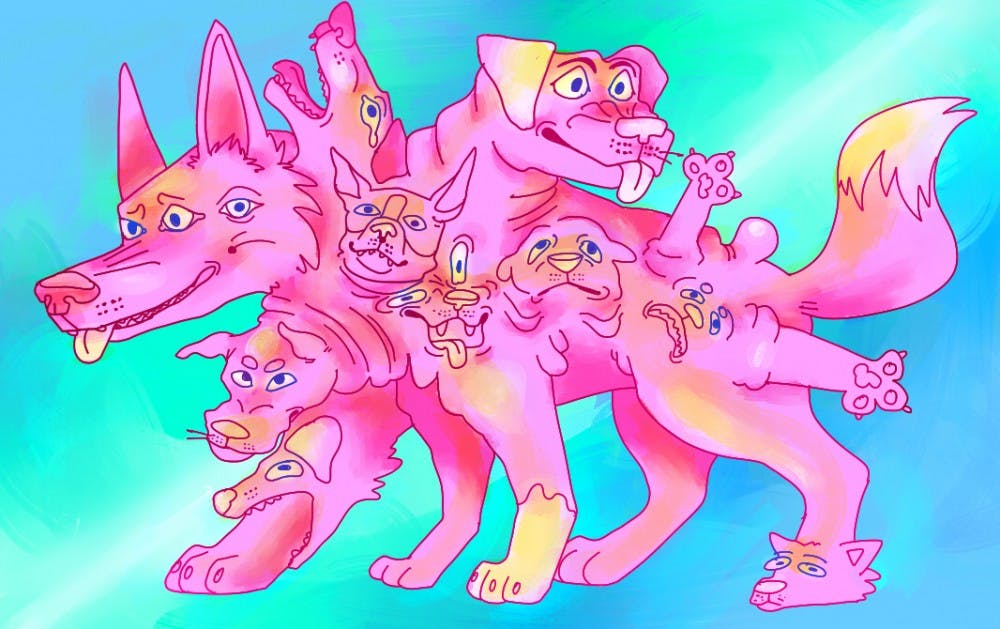Think you know your dog's ancestry? ASU researchers say think again.
The Canine Science Collaboratory within the ASU Department of Psychology set out to find the truth behind breed labels.
The team genotyped dogs from the Arizona Animal Welfare League and the Society for the Prevention of Cruelty to Animals and San Diego Humane Society and compared shelter breed assignments determined by visual appearance to that of genetic testing.
The results showed that staff at the Humane Society could match at least one breed in the genetic heritage of 67.7 percent of the dogs tested. Agreement fell to 10.4 percent when staff had to identify more than one breed.
The researchers' findings were published in PLOS ONE last month.
Lisa Gunter, a Maddie’s Research Fellow at the Canine Science Collaboratory, said that the genotyping of dogs was done through the commercially available Wisdom Panel Canine DNA test, distributed by Mars Veterinary.
The Mars test uses 321 single-nucleotide polymorphisms to identify the genetics of an individual canine.
“It is a pretty big genome ... (that's) similar to humans but not quite,” Gunter said. “(Mars has) identified these nucleotides based on a pure breed database consisting of 13,000 dogs.”
According to Gunter, adoptive families, researchers and even shelter staff are not always accurate when determining the breed of a dog by visual analysis, despite their level of expertise.
Michael Morefield, the director of marketing and communications at the welfare league said they were not the only shelter that had trouble with breed labeling.
He said the organization believes that dogs' ancestries does not affect the animal's personality or character as much as their life experiences does.
“We just wanted to know, ‘Who are these dogs?’” Gunter said.“That had never been done before.”
Data showed that over 450 dogs were tested at each of the facilities, with the three most common breed signatures being American Staffordshire Terrier, Chihuahua and Poodle. The three breeds accounted for 42.5 percent or all breed identifications at the third generation level.
According to Gunter, the most surprising result was the 125 different breeds found within the genotypes of the dogs at the welfare league.
“Most of the dogs were three breeds or more ... only 5 percent of dogs were purebred,” Gunter said. “The shelter is the home of the original designer dog. The only difference between designer dogs and shelter dogs was that in a designer dog there was intention behind the mix. There is still no difference between the dogs ability to be a companion.”
Aside from the genetic implications of the study, the findings showed flaws in the social and psychological culture surrounding dog adoption and what people are truly looking at when adopting an animal.
“We measured the impact of labels,” Gunter said. “We found at AAWL when we compared two 'look-alike' dogs groups (one labeled as a pitbull and one that looked like a pitbull), ... they waited to be adopted over three times as long.”
Gunter said that the label alone can change the perception towards the same dog.
She said that when a dog was labeled then unlabeled, they relabeled the dog less attractive.
Clive Wynne, a psychology professor and director of the Canine Science Collaboratory, said that the findings of the study should push people to move the discussion away from "What breed is your dog?" to "What kind of a dog is it?"
Wynne explained that despite knowing what a dog's mixed breeds or heritages are, the genetics behind the behavior of the animal is far too complicated to draw direct conclusions.
For Morefield, the idea that every dog is its own individual is the most important thing.
"The characteristics of that breed on a kennel card, which may or may not be true, is not who that dog is," Morefield said. "The life experiences of that dog will influence who that dog is."
Morefield said that people should not be for or against a breed, but be for a certain dog instead.
"That personality is what you will live with for the next 10 to 15 years, not something someone wrote on a card," Morefield said.
He said that the idea of shelters taking away breed labels for shelter dogs is not too far-fetched, and according to results drawn from one of the largest animal shelters in Orlando, Florida, the absence of cage card labels increased the number of adoptions.
“We have grounds for optimism that it does in fact work in the real world,” Wynne said. “It's a zero cost intervention … it’s starting to catch on."
Morefield said that moving to a system like the welfare league’s, where breed labels are kept in files and not presented on kennel cards or websites, can be beneficial for all.
"The more people and organizations learn about the inaccuracy of breed labeling, maybe we can move away entirely from labeling dogs with their breed," Morefield said. "In the meantime, you can set them up for success by eliminating it from public facing information and remaining transparent if anyone asks."
Gunter said research that looks at impacts of temporary and semi-permanent fostering of shelter dogs is in the future for the Canine Science Collaboratory.
Reach the reporter at mshrikan@asu.edu and follow @MayaShrikant on Twitter.
Like The State Press on Facebook and follow @statepress on Twitter.




